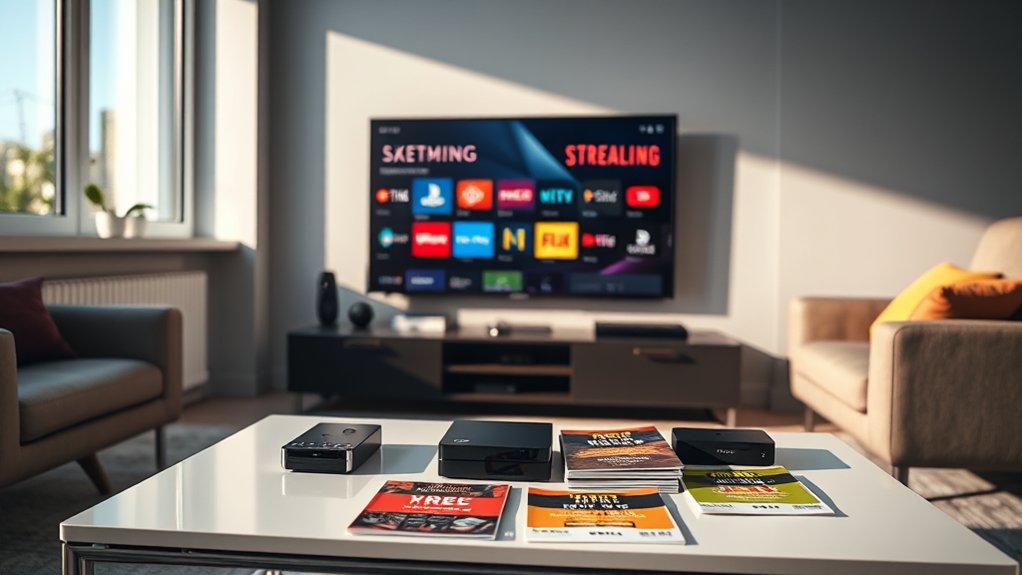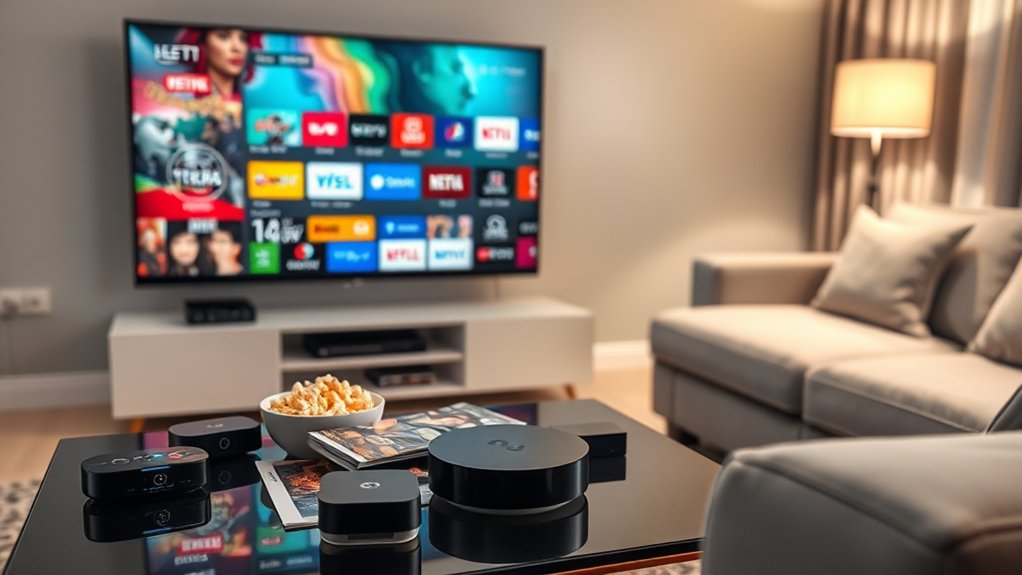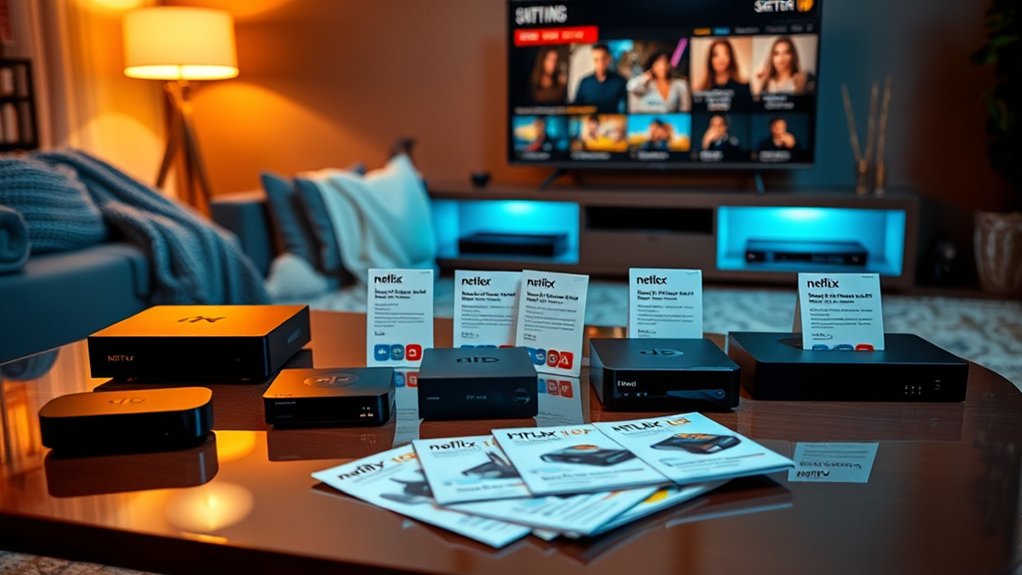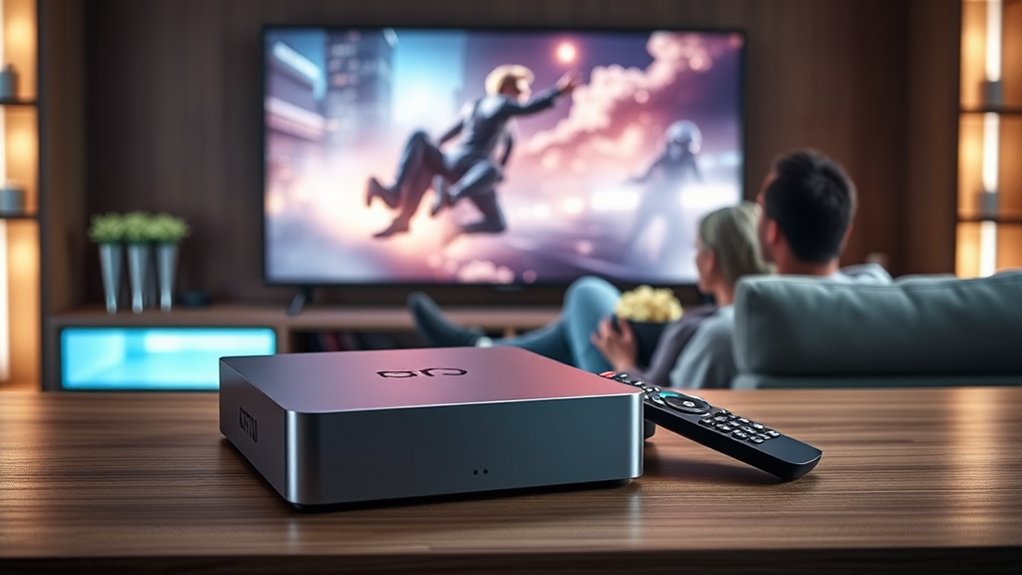When choosing streaming players with subscription plans, consider how the monthly costs stack up against your budget. Evaluate device compatibility—after all, what good’s a service if it doesn’t play nicely with your TV? Look for a variety of content, especially platforms that create original shows. Don’t forget to investigate cost-saving strategies, like sharing accounts or opting for ad-supported plans. Want to improve your viewing experience even further? There’s more to reveal!
Key Highlights
- Compare subscription costs across platforms to find the best value for your viewing habits.
- Ensure the streaming player supports major operating systems for app availability and compatibility.
- Prioritize platforms with diverse content, including original programming and specialty channels that match your interests.
- Look for user-friendly interfaces and features like voice control for a better navigation experience.
- Consider cost-saving strategies like rotating subscriptions or opting for ad-supported plans to maximize your budget.
Understanding Subscription Plans and Their Costs

As you commence your streaming adventure, it’s essential to grasp the intricate environment of subscription plans and their associated costs, especially since you want to make an informed choice that suits your viewing habits and budget.
In the U.S., the average monthly spend on streaming is around $42.38. You’ve got options like Netflix with plans ranging from $6.99 for an ad-supported experience to $22.99 for a premium, ad-free setup. Hulu and Disney+ likewise offer similar tiered pricing. However, many users are increasingly canceling subscriptions due to rising prices and limited content. Importantly, streaming services typically have lower monthly costs than cable subscriptions, which can influence your choice.
But remember, ad-supported plans, though cheaper, can cut into your binge-watching flow with interruptions. Do you want to sacrifice content access for savings?
Balancing costs with viewing comfort is vital, so weigh your options wisely!
Evaluating Device Compatibility and Performance
How do you guarantee that your streaming device delivers both reliability and best performance? Start by checking the operating system—options like Roku, Fire OS, and tvOS each have unique app availability and user interfaces that can affect your navigation experience.
Not every device supports all subscription services, so compatibility is key. Next, consider video and audio performance; if you want 4K or HDR content, your device needs to have the necessary standards. Streaming devices typically offer quicker experiences compared to smart TVs, ensuring that you can access your content without frustrating delays. Some devices, like Google TV Streamers, provide faster processing and enhanced performance for smoother streaming.
Compatibility with subscription services is crucial, along with ensuring your device can handle video and audio performance for 4K or HDR content.
Additionally, think about remote control usability—some remotes manage your TV power and volume, whereas others leave you juggling multiple remotes like a crazed magician.
Finally, assess connectivity options to confirm a strong network performance, especially in households with multiple devices vying for bandwidth.
Exploring Content Variety and Specialty Channels

After ensuring that your streaming device is up to par regarding performance and usability, the next step is to contemplate what you actually want to watch.
With platforms offering thousands of titles, like Netflix’s nearly 3,800, you’ll find plenty to investigate. But, consider the balance between movies and shows—like Amazon Prime, which had nearly 70% movies in its library. To make the best choice, look for platforms that invest heavily in original content, as they can significantly enhance your viewing experience.
Don’t forget about specialty channels! Whether you’re into horror, documentaries, or sports, dedicated content can enhance your viewing experience. Plus, original content is often a game-changer.
Implementing Cost-Saving Strategies
Maneuvering the world of streaming services can feel overwhelming, especially when trying to keep costs under control. One effective strategy is rotating subscriptions: subscribe to one or two platforms at a time, binge-watch to your heart’s content, then switch as needed.
This approach can save you serious cash since you avoid the cost of multiple services concurrently. You could also investigate bundled deals, like the Disney+ and Hulu combo, which often provides a discount compared to individual subscriptions.
If you don’t mind a few ads, consider ad-supported plans for significant savings. Finally, don’t forget about sharing accounts with family or friends—you’ll cut costs while enjoying your favorite shows together. Isn’t that better than paying full price?
Enhancing User Experience With Additional Features

As you adopt cost-saving strategies for streaming services, keep in mind that the user experience can be greatly improved through extra features found in various streaming players.
For instance, an intuitive interface upgrades navigation, making it easier to uncover content. Voice control, like Google Assistant, lets you access shows hands-free (who wouldn’t want that?).
Customizable home screens mean you can prioritize your favorite apps, as you enjoy AI-driven features presenting content tailored just for you.
Don’t overlook the rich ecosystem of over 6,500 apps or the benefits of free live TV channels.
Furthermore, support for 4K UHD streaming and smart home integrations brings your viewing experience to new heights, ensuring you enjoy every moment without missing a beat!
Frequently Asked Questions
How Do Bundling Options Impact Subscription Value Overall?
Bundling options greatly improve your subscription value by cutting costs and simplifying choices. With curated content libraries and added features, they save you money as well as keeping you engaged for longer, making them a smart choice.
What Are the Long-Term Benefits of Streaming Subscriptions?
Streaming subscriptions offer long-term benefits like diverse content, cost efficiency, and improved user experience. You’ll enjoy personalized recommendations, flexible viewing, and continuous catalog updates, ensuring you always find something engaging to watch.
Are There Limitations on Simultaneous Streams for Services?
Yes, there are limitations on simultaneous streams for many services. You’ll find caps vary; some allow just one or two streams, whereas others may permit more, depending on your chosen subscription tier.
How Do Ads Affect Viewing Experience in Ad-Supported Plans?
Ads can greatly impact your viewing experience in ad-supported plans. Fewer, relevant ads improve your enjoyment, whereas excessive interruptions may detract from it, finally affecting how engaged you feel with the content you’re watching.
Can I Switch Between Subscription Plans Easily?
Yes, you can switch between subscription plans easily. Most streaming services let you change plans online without contacting support. Just select your new plan, confirm the change, and your billing will adjust accordingly.




